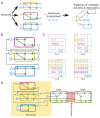Microbiome and Metabolome Insights into the Role of the Gastrointestinal-Brain Axis in Parkinson's and Alzheimer's Disease: Unveiling Potential Therapeutic Targets
- PMID: 36557259
- PMCID: PMC9786685
- DOI: 10.3390/metabo12121222
Microbiome and Metabolome Insights into the Role of the Gastrointestinal-Brain Axis in Parkinson's and Alzheimer's Disease: Unveiling Potential Therapeutic Targets
Abstract
Neurodegenerative diseases such as Parkinson's (PD) and Alzheimer's disease (AD), the prevalence of which is rapidly rising due to an aging world population and westernization of lifestyles, are expected to put a strong socioeconomic burden on health systems worldwide. Clinical trials of therapies against PD and AD have only shown limited success so far. Therefore, research has extended its scope to a systems medicine point of view, with a particular focus on the gastrointestinal-brain axis as a potential main actor in disease development and progression. Microbiome and metabolome studies have already revealed important insights into disease mechanisms. Both the microbiome and metabolome can be easily manipulated by dietary and lifestyle interventions, and might thus offer novel, readily available therapeutic options to prevent the onset as well as the progression of PD and AD. This review summarizes our current knowledge on the interplay between microbiota, metabolites, and neurodegeneration along the gastrointestinal-brain axis. We further illustrate state-of-the art methods of microbiome and metabolome research as well as metabolic modeling that facilitate the identification of disease pathomechanisms. We conclude with therapeutic options to modulate microbiome composition to prevent or delay neurodegeneration and illustrate potential future research directions to fight PD and AD.
Keywords: Alzheimer’s disease; Parkinson’s disease; gastrointestinal–brain axis; metabolomics; microbiome; microbiome modelling; neurodegenerative diseases; therapeutic interventions.
Conflict of interest statement
The authors declare no conflict of interest.
Figures


References
-
- Berg D., Postuma R.B., Bloem B., Chan P., Dubois B., Gasser T., Goetz C.G., Halliday G.M., Hardy J., Lang A.E., et al. Time to Redefine PD? Introductory Statement of the MDS Task Force on the Definition of Parkinson’s Disease. Mov. Disord. 2014;29:454–462. doi: 10.1002/mds.25844. - DOI - PMC - PubMed
Publication types
Grants and funding
- 01ZX1912A/Federal Ministry of Education and Research
- CRC 1182 Metaorganisms/Deutsche Forschungsgemeinschaft
- EXC 2167 "Precision Medicine in Chronic Inflammation"/Deutsche Forschungsgemeinschaft
- KA 3541/18-1/Deutsche Forschungsgemeinschaft
- Else Kröner-Fresenius Stiftung: Interdisciplinary Else Kröner-Research College Kiel: The Role of the Gut-Brain-Axis in Neuroinflammation and Neurodegeneration Deutsche Forschungsgemeinschaft: Clinician Scientist Program in Evolutionary Medicine (CSEM)
LinkOut - more resources
Full Text Sources

